1993 BUICK REGAL air condition
[x] Cancel search: air conditionPage 248 of 308
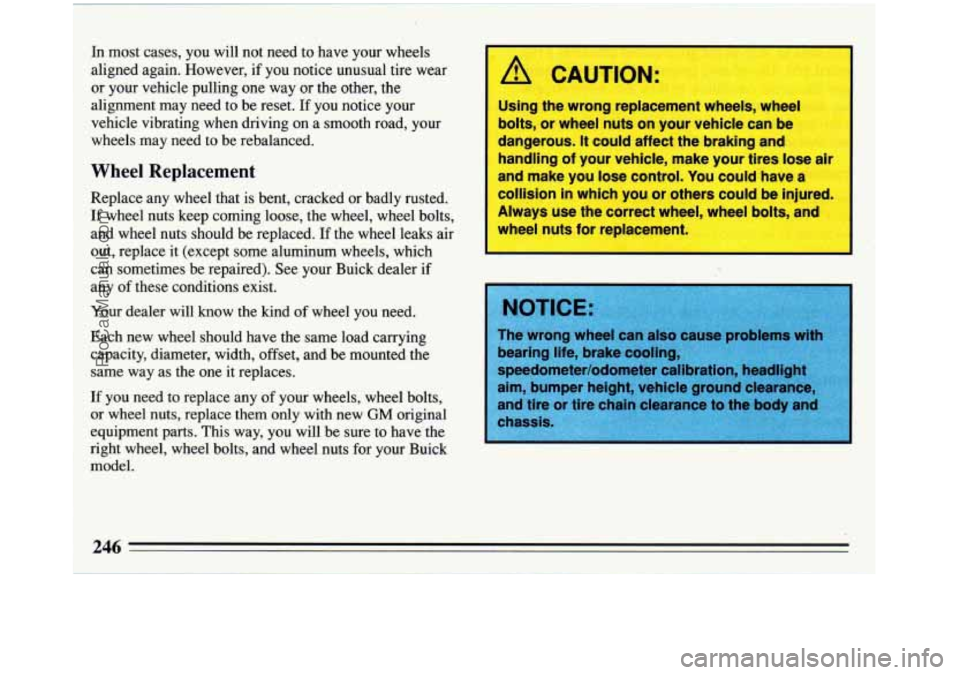
In most cases, you will not need to have your wheels
aligned again. However, if
you notice unusual tire wear
or your vehicle pulling one way or the other, the
alignment may need to be reset.
If you notice your
vehicle vibrating when driving on a smooth road, your
wheels may need to be rebalanced.
Wheel Replacement
Replace any wheel that is bent, cracked or badly rusted.
If wheel nuts keep coming loose, the wheel, wheel bolts,
and wheel nuts should be replaced. If the wheel leaks air
out, replace it (except some aluminum wheels, which
can sometimes be repaired). See your Buick dealer if
any
of these conditions exist.
Your dealer will know the kind of wheel you need.
Each new wheel should have the same load carrying
capacity, diameter, width, offset, and be mounted the
same way as the one it replaces.
If you need to replace any of your wheels, wheel bolts,
or wheel nuts, replace them only with new
GM original
equipment parts. This way, you will be sure to have the
right wheel, wheel bolts, and wheel nuts for your Buick
model.
A CAUTION:
Using the wrong replacement wheels, wheel
bolts, or wheel nuts on your vehicle can be
dangerous.
It could affect the braking and
handling of your vehicle, make your tires lose air
and make you lose control. You could have a
collision in which you or others could be injured.
Always use the correct wheel, wheel bolts, and
wheel nuts for replacement.
I I
1:-
ProCarManuals.com
Page 256 of 308
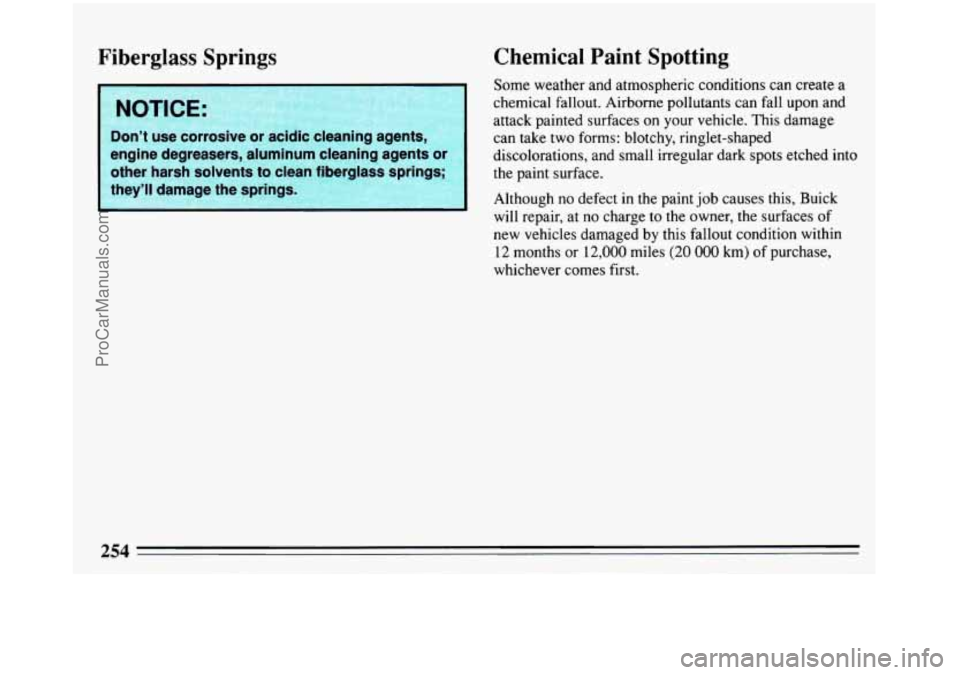
Fiberglass Springs Chemical Paint
Spotting
. __ - . , . , .. , x ii
&
.x .-., .i Some weather and atmospheric conditions can create a
>.. >:_ .g I:
e;
& I E
:
NOTICE:
engine degreasers, aluminum cleaning agents or discolorations, and small irregular dark spots etched into
chemical fallout. Airborne pollutants can fall
upon and
attack painted surfaces on your vehicle. This damage
Don’t use corrosive or acidic cleaning agents, can take two forms: blotchy, ringlet-shaped
other harsh solvents to cle rqlass Springs; 1 the paint surface.
they’ll damage the springs 8 Although no defect in the paint job causes this, Buick ;1 will repair, at no charge to-the owner, the surfaces of
new vehicles damaged by this fallout condition within
12 months or 12,000 miles (20
000 km) of purchase,
whichever comes first.
254
ProCarManuals.com
Page 265 of 308
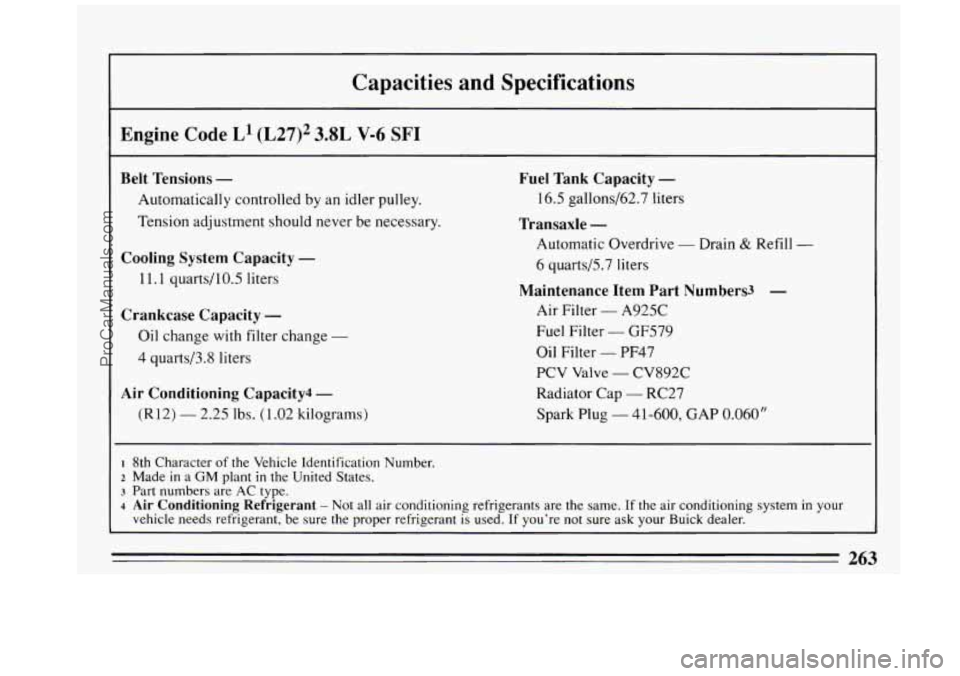
Capacities and Specifications
Engine Code L1 (L27)2 3.8L V-6 SF1
Belt Tensions - Fuel Tank Capacity -
Automatically controlled by an idler pulley.
16.5 gallons/62.7 liters
Tension adjustment should never be necessary.
Transaxle -
Automatic Overdrive - Drain & Refill -
6 quarts/5.7 liters
Maintenance Item Part Numbers3 -
Air Filter - A925C
Fuel Filter
- GF579
Oil Filter
- PF47
PCV Valve
- CV892C
Radiator Cap
- RC27
Spark Plug
- 41-600, GAP 0.060”
Cooling System Capacity -
11.1 quarts/l0.5 liters
Crankcase Capacity -
Oil change with filter change -
4 quarts/3.8 liters
Air Conditioning Capacity4 -
(R12) - 2.25 lbs. (1.02 kilograms)
-
4 Air Conditioning Refrigerant - Not all air conditioning refrigerants are the same. If the air conditioning system in your
vehicle needs refrigerant, be sure the proper refrigerant
is used. If you’re not sure ask your Buick dealer.
~ ~~
I 8th Character of the Vehicle Identification Number.
2 Made in a GM plant in the United States.
3 Part numbers are AC tvDe.
263
ProCarManuals.com
Page 266 of 308
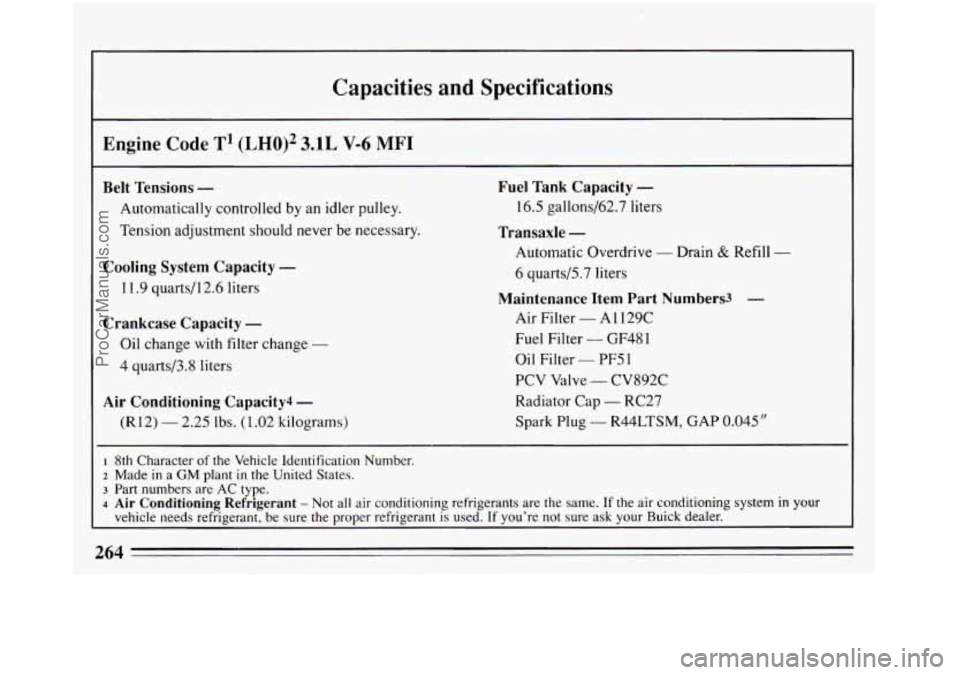
Capacities and Specifications
Engine Code T1 (LH0)2 3.1L V-6 MFI
Belt Tensions -
Automatically controlled by an idler pulley.
Tension adjustment should never be necessary.
Cooling System Capacity -
11.9 quarts/l2.6 liters
Crankcase Capacity -
Oil change with filter change -
4 quarts/3.8 liters
Air Conditioning Capacity4 -
(R12) - 2.25 Ibs. (1.02 kilograms)
Fuel Tank Capacity -
16.5 gallons/62.7 liters
1 ransaxle -
Automatic Overdrive - Drain & Refil 1-
6 quartd5.7 liters
Maintenance Item Part Numbers3 -
Air Filter - A1 129C
Fuel Filter
- GF48 1
Oil Filter - PF5 1
PCV Valve - CV892C
Radiator Cap
- RC27
Spark Plug
- R44LTSM, GAP 0.045”
~~ ~
1 8th Character of the Vehicle Identification Number.
z Made in a GM plant in the United States.
3 Part numbers are AC type.
4 Air Conditioning Refrigerant - Not all air conditioning refrigerants are the same. If the air conditioning system in your
vehicle needs refrig
nt, be sure the proper refrigerant is used. If you’re not sure ask your Buick dealer.
264
ProCarManuals.com
Page 269 of 308
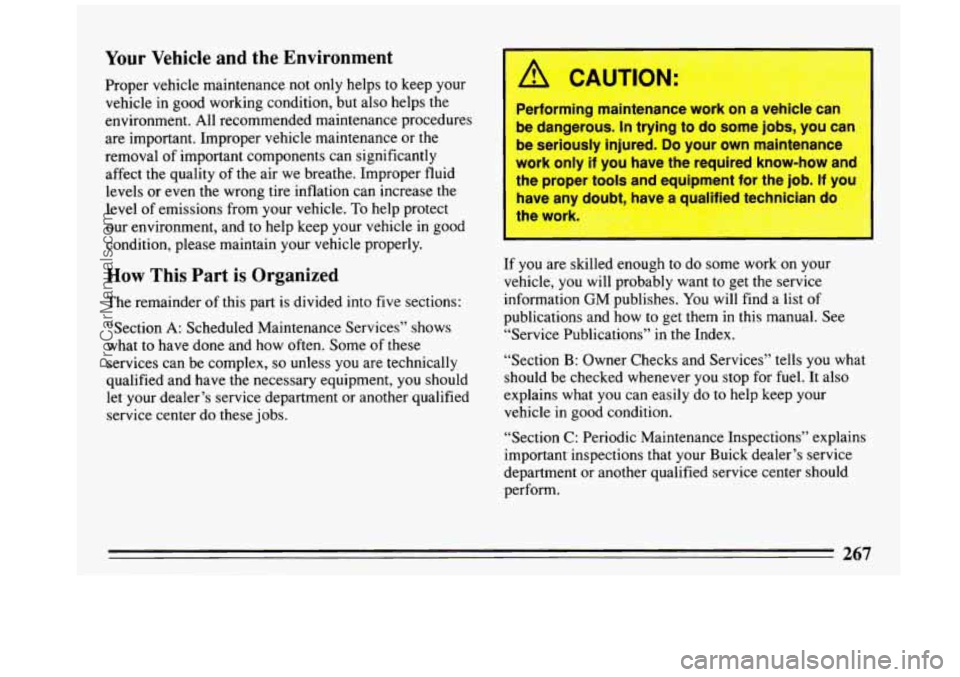
Your Vehicle and the Environment
Proper vehicle maintenance not only helps to keep your
vehicle in good working condition, but also helps the
environment. All recommended maintenance procedures
are important. Improper vehicle maintenance or the
removal of important components can significantly
affect the quality of the air we breathe. Improper fluid
levels or even the wrong tire inflation can increase the
level of emissions from your vehicle. To help protect
our environment, and to help keep your vehicle in
good
condition, please maintain your vehicle properly.
How This Part is Organized
The remainder of this part is divided into five sections:
“Section
A: Scheduled Maintenance Services” shows
what to have done and how often. Some of these
services can be complex,
so unless you are technically
qualified and have the necessary equipment, you should
let your dealer’s service department or another qualified
service center do these jobs.
e dangerous. In trying to do some jobs, you ca
le seriously injured.
Do your own maintenanc
work only if you have the required know-how and
:he proper tools and equipment for the job.
If you
have any lubt, have a qualified technic’
1 do
the work.
If you are skilled enough to do some work on your
vehicle, you will probably want to get the service
information GM publishes. You
will find a list of
publications and how to get them
in this manual. See
“Service Publications”
in the Index.
“Section B: Owner Checks and Services” tells you what
should be checked whenever you stop for fuel. It also
explains what you can easily do to help keep your
vehicle in good condition.
“Section
C: Periodic Maintenance Inspections” explains
important inspections that your Buick dealer’s service
department or another qualified service center should
perform.
267
ProCarManuals.com
Page 277 of 308

conditioning condenser. Wash the pressure cap and
neck.
To help ensure proper operation, we recommend a
pressure test of both the cooling system and the
pressure cap.
7. Transaxle Service -- Change both the fluid and
filter every
15,000 miles (25 000 km) if the vehicle
is mainly driven under one or more of these
conditions:
0 In heavy city traffic where the outside
temperature regularly reaches
90 F (32 C) or
higher.
In hilly or mountainous terrain.
When doing frequent trailer towing.
Uses such as found in taxi, police car or delivery
If you do not use your vehicle under any of these
conditions, change both the fluid and filter every
100,000 miles ( 160 000 km).
service.
8. Spark Plug Replacement* -- Replace
spark plugs
with the proper type. See “Specifications Chart” in
the Index.
9. Spark Plug Wire Inspection”? -- Inspect for
burns, cracks or other damage. Check the boot fit at
the distributor and at the spark plugs. Replace wires
as needed.
10.
Air Cleaner Filter Replacement* -- Replace every
30,000 miles (50 000 km) or more often under dusty
conditions. Ask your dealer for the proper
replacement intervals for your driving conditions.
11
.. Fuel Tank, Cap and Lines Inspection”? -- Inspect
fuel tank, cap and lines (including fuel rails and
injection assembly, if equipped) for damage or leaks.
Inspect fuel cap gasket for an even filler neck
imprint or any damage. Replace parts as needed.
Periodic replacement of the fuel filter is not required.
275
ProCarManuals.com
Page 281 of 308

CHECK OR
I SERVICE WHAT TO DO
Underbody
Flushing At
least every spring, use plain water
to flush any corrosive materials from
the underbody. Take care to clean
thoroughly any areas where mud and
other debris can collect.
Section C: Periodic Maintenance
Inspections
Listed below are inspections and services which s ,hou !Id
be performed at least twice a year (for instance, each
spring and fall).
You should let your GM dealer’s
service department or other qualified service center do
these jobs. Make sure any necessary repairs are
completed at once.
INSPECTION
OR SERVICE
Steering,
Suspension and
Front-Wheel- Drive Axle
Boot and Seal
Inspection
Exhaust System
Inspection
Throttle Linkage
Inspection
WHAT SHOULD BE DONE
Inspect the front and rear suspension
and steering system for damaged, loose or missing parts, signs of wear,
or lack of lubrication. Inspect
the
power steering lines and hoses for
proper hookup, binding, leaks,
cracks, chafing, etc. Clean and then
inspect the drive axle boot seals for
damage, tears or leakage. Replace
seals
if necessary.
Inspect the complete exhaust
system. Inspect the body near
the
exhaust system. Look for broken,
damaged, missing or out-of-position
parts as well as open seams, holes,
loose connections, or other conditions which could cause
a heat
build-up
in the floor pan or could let
exhaust fumes into the vehicle. See
“Engine Exhaust”
in the Index.
Inspect the throttle linkage for
interference or binding, and for
damaged or missing parts. Replace
parts
as needed.
279
ProCarManuals.com
Page 290 of 308
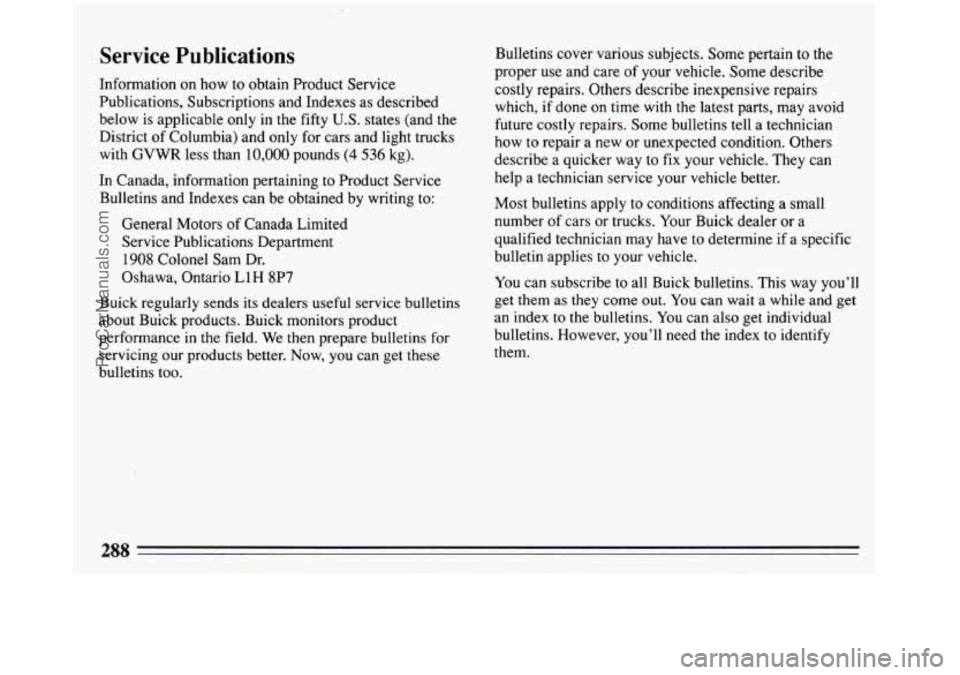
Service Publications
Information on how to obtain Product Service
Publications, Subscriptions and Indexes as described
below is applicable only in the fifty
U.S. states (and the
District of Columbia) and only for cars and light trucks
with
GVWR less than 10,000 pounds (4 536 kg).
In Canada, information pertaining to Product Service
Bulletins and Indexes can be obtained by writing to:
General Motors of Canada Limited
Service Publications Department
1908 Colonel Sam Dr.
Oshawa, Ontario L
1 H 8P7
Buick regularly sends its dealers useful service bulletins
about Buick products. Buick monitors product
performance in the field. We then prepare bulletins for
servicing our products better. Now, you can get
these
bulletins too. Bulletins cover various subjects.
Some pertain to the
proper
use and care of your vehicle. Some describe
costly repairs. Others describe inexpensive repairs
which, if done on time with the latest parts, may avoid
future costly repairs. Some bulletins tell a technician
how
to repair a new or unexpected condition. Others
describe a quicker way to fix your vehicle. They can
help a technician service your vehicle better.
Most bulletins apply
to conditions affecting a small
number of cars or trucks. Your Buick dealer or a
qualified technician may have to determine if a specific
bulletin applies to your vehicle.
You can subscribe to all Buick bulletins. This way
you’ll
get them as they come out. You can wait a while and get
an index to the bulletins. You can also get individual
bulletins. However,
you’ll need the index to identify
them.
288
-
ProCarManuals.com